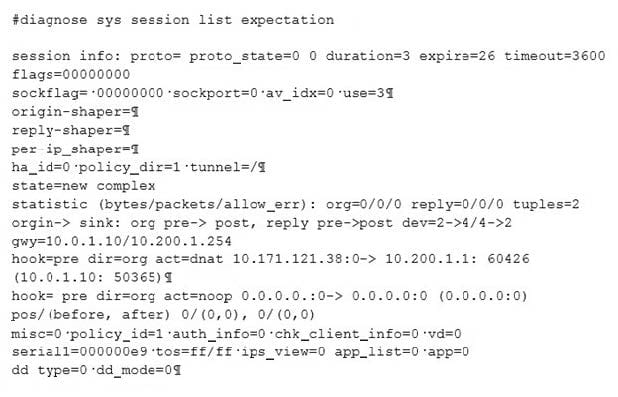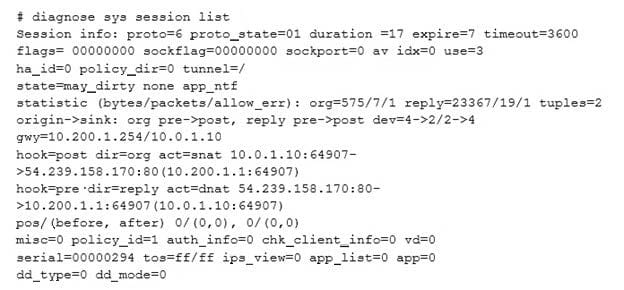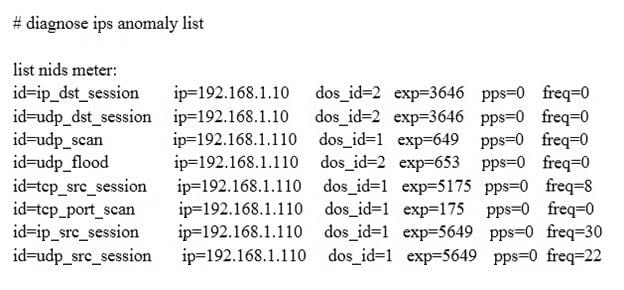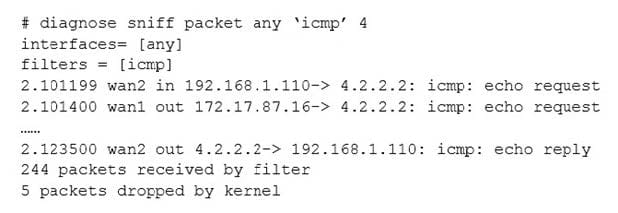Exam Details
Exam Code
:NSE7Exam Name
:Fortinet Troubleshooting ProfessionalCertification
:Fortinet CertificationsVendor
:FortinetTotal Questions
:88 Q&AsLast Updated
:Aug 07, 2025
Fortinet Fortinet Certifications NSE7 Questions & Answers
-
Question 11:
View these partial outputs from two routing debug commands: Which outbound interface will FortiGate use to route web traffic from internal users to the Internet?

A. Both port1 and port2
B. port3
C. port1
D. port2
-
Question 12:
Examine the output of the `diagnose sys session list expectation' command shown in the exhibit; than answer the question below.

Which statement is true regarding the session in the exhibit?
A. It was created by the FortiGate kernel to allow push updates from FotiGuard.
B. It is for management traffic terminating at the FortiGate.
C. It is for traffic originated from the FortiGate.
D. It was created by a session helper or ALG.
-
Question 13:
An administrator has configured a FortiGate device with two VDOMs: root and internal. The administrator has also created and inter-VDOM link that connects both VDOMs. The objective is to have each VDOM advertise some routes to the other VDOM via OSPF through the inter-VDOM link. What OSPF configuration settings must match in both VDOMs to have the OSPF adjacency successfully forming? (Choose three.)
A. Router ID.
B. OSPF interface area.
C. OSPF interface cost.
D. OSPF interface MTU.
E. Interface subnet mask.
-
Question 14:
When does a RADIUS server send an Access-Challenge packet?
A. The server does not have the user credentials yet.
B. The server requires more information from the user, such as the token code for two- factor authentication.
C. The user credentials are wrong.
D. The user account is not found in the server.
-
Question 15:
A FortiGate has two default routes: All Internet traffic is currently using port1. The exhibit shows partial information for one sample session of Internet traffic from an internal user:


What would happen with the traffic matching the above session if the priority on the first default route (IDd1) were changed from 5 to 20?
A. Session would remain in the session table and its traffic would keep using port1 as the outgoing interface.
B. Session would remain in the session table and its traffic would start using port2 as the outgoing interface.
C. Session would be deleted, so the client would need to start a new session.
D. Session would remain in the session table and its traffic would be shared between port1 and port2.
-
Question 16:
Examine the following partial outputs from two routing debug commands; then answer the question below:

Why the default route using port2 is not displayed in the output of the second command?
A. It has a lower priority than the default route using port1.
B. It has a higher priority than the default route using port1.
C. It has a higher distance than the default route using port1.
D. It is disabled in the FortiGate configuration.
-
Question 17:
What is the purpose of an internal segmentation firewall (ISFW)?
A. It inspects incoming traffic to protect services in the corporate DMZ.
B. It is the first line of defense at the network perimeter.
C. It splits the network into multiple security segments to minimize the impact of breaches.
D. It is an all-in-one security appliance that is placed at remote sites to extend the enterprise network.
-
Question 18:
View the exhibit, which contains the partial output of an IKE real-time debug, and then answer the question below.
ike 0: comes 10.0.0.2:500->10.0.0.1:500, ifindex=7.... ike 0: IKEv1 exchange=Aggressive id=baf47d0988e9237f/2f405ef3952f6fda len=430 ike 0: in
BAF47D0988E9237F2F405EF3952F6FDA0110040000000000000001AE0400003C00000 00100000001000000300101000 ike 0:RemoteSite:4: initiator: aggressive mode get 1st response... ike 0:RemoteSite:4: VID RFC 3947 4A131c81070358455C5728F20E95452F ike 0:RemoteSite:4: VID DPD AFCAD71368A1F1C96B8696FC77570100 ike 0:RemoteSite:4: VID FORTIGATE 8299031757A36082C6A621DE000502D7 ike 0:RemoteSite:4: peer is FortiGate/Fortios (v5 b727)
ike 0:RemoteSite:4: VID FRAGMENTATION 4048B7D56EBCE88525E7DE7F00D6C2D3 ike 0:RemoteSite:4: VID FRAGMENTATION 4048B7D56EBCE88525E7DE7F00D6C2D3C0000000
ike 0:RemoteSite:4: received peer identifier FQDN `remore'
ike 0:RemoteSite:4: negotiation result
ike 0:RemoteSite:4: proposal id = 1:
ike 0:RemoteSite:4: protocol id = ISAKMP:
ike 0:RemoteSite:4: trans_id = KEY_IKE.
ike 0:RemoteSite:4: encapsulation = IKE/none
ike 0:RemoteSite:4: type=OAKLEY_ENCRYPT_ALG, val=AES_CBC, key 璴en=128
ike 0:RemoteSite:4: type=OAKLEY_HASH_ALG, val=SHA.
ike 0:RemoteSite:4: type-AUTH_METHOD, val=PRESHARED_KEY.
ike 0:RemoteSite:4: type=OAKLEY_GROUP, val=MODP1024.
ike 0:RemoteSite:4: ISAKMP SA lifetime=86400
ike 0:RemoteSite:4: ISAKMP SA baf47d0988e9237f/2f405ef3952f6fda key 16:
B25B6C9384D8BDB24E3DA3DC90CF5E73
ike 0:RemoteSite:4: PSK authentication succeeded
ike 0:RemoteSite:4: authentication OK
ike 0:RemoteSite:4: add INITIAL-CONTACT
ike 0:RemoteSite:4: enc BAF47D0988E9237F405EF3952F6FDA081004010000000000000080140000181F2E48BF D8E9D603F ike 0:RemoteSite:4: out
BAF47D0988E9237F405EF3952F6FDA08100401000000000000008C2E3FC9BA061816A 396F009A12
ike 0:RemoteSite:4: sent IKE msg (agg_i2send): 10.0.0.1:500-10.0.0.2:500, len=140, id=baf47d0988e9237f/2 ike 0:RemoteSite:4: established IKE SA baf47d0988e9237f/2f405ef3952f6fda
Which statements about this debug output are correct? (Choose two.)
A. The remote gateway IP address is 10.0.0.1.
B. It shows a phase 1 negotiation.
C. The negotiation is using AES128 encryption with CBC hash.
D. The initiator has provided remote as its IPsec peer ID.
-
Question 19:
Examine the output of the `diagnose ips anomaly list' command shown in the exhibit; then answer the question below.

Which IP addresses are included in the output of this command?
A. Those whose traffic matches a DoS policy.
B. Those whose traffic matches an IPS sensor.
C. Those whose traffic exceeded a threshold of a matching DoS policy.
D. Those whose traffic was detected as an anomaly by an IPS sensor.
-
Question 20:
Examine the following partial output from a sniffer command; then answer the question below.

What is the meaning of the packets dropped counter at the end of the sniffer?
A. Number of packets that didn't match the sniffer filter.
B. Number of total packets dropped by the FortiGate.
C. Number of packets that matched the sniffer filter and were dropped by the FortiGate.
D. Number of packets that matched the sniffer filter but could not be captured by the sniffer.
Related Exams:
FCP_FAZ_AD-7.4
FCP - FortiAnalyzer 7.4 AdministratorFCP_FGT_AD-7.4
FCP - FortiGate 7.4 AdministratorFCP_FGT_AD-7.6
FortiGate 7.6 Administrator FCP_FGT_AD-7.6FCP_WCS_AD-7.4
FCP - AWS Cloud Security 7.4 AdministratorFCSS_EFW_AD-7.4
FCSS - Enterprise Firewall 7.4 AdministratorFCSS_NST_SE-7.4
FCSS - Network Security 7.4 Support EngineerFCSS_SASE_AD-24
FCSS - FortiSASE 24 AdministratorNSE4_FGT-5.6
Fortinet NSE 4 - FortiOS 5.6NSE4_FGT-6.0
Fortinet NSE 4 - FortiOS 6.0NSE4_FGT-6.4
Fortinet NSE 4 - FortiOS 6.4
Tips on How to Prepare for the Exams
Nowadays, the certification exams become more and more important and required by more and more enterprises when applying for a job. But how to prepare for the exam effectively? How to prepare for the exam in a short time with less efforts? How to get a ideal result and how to find the most reliable resources? Here on Vcedump.com, you will find all the answers. Vcedump.com provide not only Fortinet exam questions, answers and explanations but also complete assistance on your exam preparation and certification application. If you are confused on your NSE7 exam preparations and Fortinet certification application, do not hesitate to visit our Vcedump.com to find your solutions here.